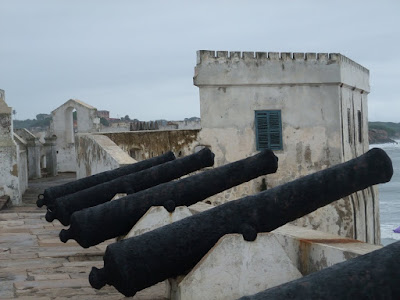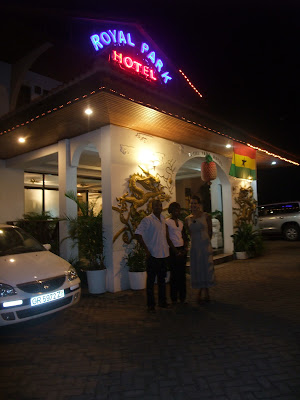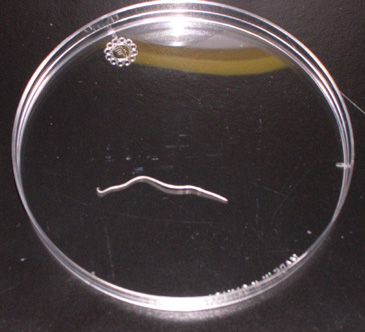The Ghanaian food journey continues. Below are some local food highlights. I don’t think variety is a characteristic of Ghanaian food…I just may have tried it all within three weeks!
Before I go on, I will admit that I broke my rule of not eating any non-local food within the first week I was in Ghana. We discovered the famous
obroni restaurant,
Vic Baboo’s, while wandering around Kumasi and just had to stop in to try it out. Vic Baboo’s is an Indian restaurant that claims to serve local food, American, Italian, Indian, and Chinese. I went with Indian since it was an Indian restaurant and Erika went with Hawaiian pizza--both were pretty good!
Sir Max is another
obroni option in Kumasi that I think is owned by Lebanese folk. We went to Sir Max with a few of the Ghanaian med students and I don’t think they are big fans of middle eastern food. I think they were actually disgusted by the
baba ganoush I ordered.
Fufu



Fufu is a very unique type of Ghanaian dish. It looks like a ball of dough, but is actually pounded and mashed plantains and cassava mixed together. I think the mixed ball of dough is then boiled/steamed, but I’m not sure, especially since
obroni usually get diarrhea after their first time eating fufu (thank goodness this didn’t happen to me!). Fufu is eaten with light soup, a spicy tomato based stew that has meat and fish poured on top of it. What may be fun for some is that you typically eat this dish with your hands. I say “fun for some” because I have this inexplicable fear of eating in public because I don’t like making a mess while I’m eating and having everyone see it. I generally avoid foods like ribs and wings when at restaurants even though I think they are tasty. I prefer a white pasta sauce over red and I eat messy finger foods with utensils. So, you can imagine how painful it was for me to eat fufu with my hands especially when the hospital administrator’s wife was staring at me. I was told that you were not supposed to chew on the fufu and just swallow it. That’s not difficult to do, but it seems so strange. So, I’d let it slosh around my mouth once or twice to taste it and then swallow. The fufu is kind of bland and tasteless. You can almost taste the plantain, but not really. I thought the light soup was super spicy. I guess the fufu is a good flavor balance to the light soup. After humoring the hospital administrator’s wife by eating with my hands. I gave up and asked for a spoon.
Just a few days later, the hospital administrator’s wife asked me to help her prepare fufu. It is usually prepared by two people. One person sitting by the mortar adding water to the mixture and folding the “dough” and the other person standing holding a large stick of bamboo with a flat blunted end to act as the pestle. I was very unsuccessful at the pounding because I was afraid I’d squash the hospital administrator’s wife’s fingers. I was also very reluctant to put in work and energy after showering into something I didn’t think was all that appetizing. The cost of sweating was not worth it! Thankfully, I think she got frustrated with my hesitant pounding and asked a scrawny fifteen year old to help her who was much more forceful with her pounding.
Cost: 2 Cedi
Banku


Banku can be seen as a variation of fufu, but made of slightly fermented maize meal and mashed cassava. Banku also has that big ball of dough appearance but has a little more stiffness to it…kind of like oatmeal that doesn’t have enough milk in it. Instead of light soup, Banku is eaten with okra (okro in Twi) stew. If any of you have cooked with okra before, you know that it has a sliminess to it. Chopping up okra leaves is actually slimier. The okra and okra leaves are what give the soup is gooey texture. The okra stew is also tomato based and includes palm oil (red in color) and fish. Banku is also eaten with your hands. I never thought I’d be thankful for the power going out, but I used my difficulty of eating in the dark to get a spoon to finish off my Banku. I actually really enjoyed Banku. I think it’s because I really miss the taste of vegetables!
Cost: 2 Cedi
Jollof Rice

Jollof Rice is a spicy type of rice usually served with chicken. I’m not quite sure what actually gives it it’s orange color and spicy taste, but my guess is the red pepper that’s used in almost every Ghanaian dish. It could also be Shito sauce (a horribly named spicy tomato/fish sauce). My guide book calls this the West African paella, but I haven’t seen Jollof rice served with anything but chicken, so I don’t think that’s the best description.
Cost: 3-5 Cedi
Rice/Noodles/Yams with Tomato Stew



Because food is extremely hard to come by out in Agroyesum, the Matron’s sister cooked for me while I was there. I think it’s now clear that she’d try to cook me “American” dishes for dinner, which I really appreciate even though everything came with a Ghanaian twist. Most of my Ghanaian-American dishes included a starch (rice, noodles, yams) along with a tomato based stew that included either chicken, beef, or fish with some chopped cabbage, green pepper, and onion mixed in. The tip-off that I was eating Ghanaian-American dishes rather than true Ghanaian dishes was when I got an entire pot filled with French fries in it and when I offered them to the hospital administrator’s family, they refused them! I’ve never met anyone who didn’t like French fries. They said that they didn’t like potatoes. This confuses me since I don’t think potatoes taste all that different from the water yam…
Cost: 2-6 Cedi
Red Red


In my
previous blog post about Ghanaian food, I described fried plantains served with a bean stew. It has just been clarified that this dish is called Red Red. I still think hands down that fried plantains are my favorite Ghanaian thing to eat.
Cost: 2-8 Cedi
All of the above are sold on the streets, though, unlike other countries I have visited, street food is a lot less common in Ghana. You can’t really eat your way through a city. I think this is why eating and finding food is so difficult in Ghana. A trip out to get food always takes at least an hour (not including the incredibly slow service at restaurants). Below are few things that you can also pick up on the street but are not really restaurant menu items.
Ghanaian Sandwich


I don’t actually know how common this type of sandwich is, but here’s Ghana’s take on an American staple: bread, onions, lettuce, chicken, beans, hard boiled eggs, ketchup, and mayo. I bought this sandwich as alcohol poisoning prophylaxis, but I think the combo of ketchup and mayo only added to me confirming any American partying stereotypes. :(
Cost: 2 Cedi
Fried Egg Sandwich
If you are really craving a nice departure from rice based meals or need a quick protein heavy breakfast, a fried egg sandwich is a great cheap option. The fried egg sandwich is exactly that, but a few things to keep in mind:
1) The eggs are smaller in Ghana and the yolk is not very yellow. Don’t be fooled, egg whites only is not the standard here. The yolk is in there somewhere.
2) Without even asking for it, you will sometimes get egg sandwiches with a few diced tomatoes and green onions (aka the Ghanaian Spanish omelet). Beware if you don’t like tomatoes or green onions.
3) Bread is sold by length rather than slices. To make a sandwich you’ll probably need about 30 peswas (Ghanaian cents) worth of bread.
Cost: 1 Cedi
Meat Pies

If you’ve ever been to a potluck that my family has been invited to, you will know what Chinese curry pockets are. I like to think that this is Ghana’s version of my mom’s Chinese curry pockets. The Ghanaian version is really just a meat pie that normally doesn’t have that much meat in it. I can’t put a finger on the spices in the meat. One meat pie had a sun-dried tomato flavor to it. The pastry portion of the pie is very flaky and very dry, so eat with plenty of water!
Cost: 50 peswas to 1 Cedi
Goat/Beef Kebobs

Of all of the advice my mentor gave to both Erika and I before leaving us in Ghana to fend for ourselves, he was most enthusiastic about Ghana’s goat kebobs. This is definitely your typical type of street food: a guy standing behind a unstable looking grill. These kebobs can be of any type of meat, but I’ve seen only goat and beef so far. You can also get any part of a cow, except I have not seen cow tongue, which I told one griller would be a hit, but he didn’t believe me. The meat is marinated in the same red pepper and the kebobs are cooked upon order. So, as you are salivating, you are also praying that the meat is cooked well and that the hot metal grid is hot enough to kill anything that could kill you!
Cost: 1 Cedi per kebob
After almost a month in Ghana, I’m seriously craving some good Chinese food. My sister’s Shanghai food pictures only add to my cravings. After Erika’s very unfortunate Chinese sweet and sour chicken at Vic Baboo’s I’m going to steer clear of anything Ghanaian-Chinese…It’s really too bad that I’m flying back straight to Ann Arbor, where the Chinese food is not really great. I really should make a pit stop at home!














































